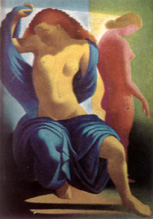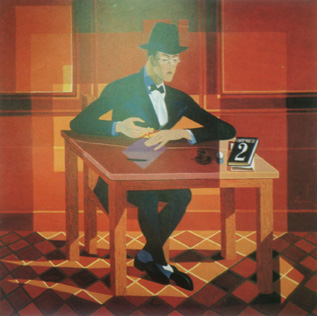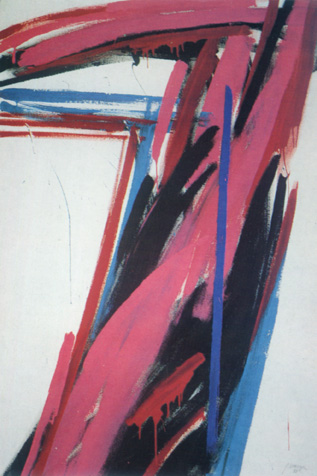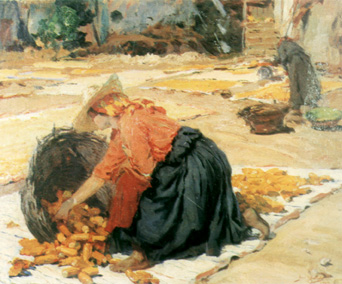 "Tribute to Luca Signoreli", by José de Almada Negreiros
"Tribute to Luca Signoreli", by José de Almada Negreiros
A tableful of beans.
The gesture of gathering them up in a single heap and the gesture of separating them, one by one, from the heap.
The first gesture is much simpler and takes less time then the second one.
If it were not a table but a territory, instead of beans there would be people. To gather every one of them in a single heap is a less complicated task than that of personalizing each one.
The first gesture, that of gathering, uniting, joining into one, every person in one territory, is the process of civilization.
The second gesture, that of personalizing each being who belongs to a civilization, is the process of CULTURE.
It is more difficult to pass from civilization to culture than to form civilization.
Civilization is a collective phenomenom.
Culture is an individual one.
There is no culture without civilization, and there is no civilization that can perdure without culture.
José de Almada Negreiros
 "Portrait of Fernando Pessoa" by José de Almada Negreiros 1964 (Oil-painting on canvas, 225×226 cms)
"Portrait of Fernando Pessoa" by José de Almada Negreiros 1964 (Oil-painting on canvas, 225×226 cms)
The capacity for materialization which economic viability allows has been at the origin of the exhibition held, in Macau, between November 1986 and March 87, of the cream of Portuguese Naturalist painting, of the most meaningful instances of Columbano's works, among which we must certainly emphasize 'Concerto de Amadores' (Amateurs' concert), 'O Grupo do Leão (The Lion Group), 'Luva Cinzenta' (Grey Glove) and two of the best instances of Portuguese intimist painting, which Columbano simply named 'still lives'. In the display of Portuguese artistic thought, there followed the works of Amadeo, Vieira da Silva, Almada Negreiros and Sarah Afonso, his wife, Bernardo Marques, Carlos Botelho, Eduardo Viana, Mário Eloy, and Abel Manta, among others.
The exhibition that followed, entirely dedicated to the works and personality of Almada Negreiros, was an opportunity to display the artist's 'Duplo--Retrato' (Double Portrait), his ornamental paintings, drawings and caricatures, 'Retrato de Fernando Pessoa ORPHEU 2' (Portrait of Fernando Pessoa ORPHEU 2), and the tapestries representing the 'Gare Marítima' (Sea-Wharf) and the preliminary sketches.
Next came the period between the 40's and the 60's where some of the artists of the first Modernist Generation were still active and important new painters also appeared and acquired a name: Júlio Pomar, António Pedro, Joaquim Rodrigo, Fernando de Azevedo, Costa Pinto, Hogan, Cruzeiro Seixas, Vespeira, Fernando Lanhas, Menez, Nikias, Eurico Gonçalves, and others.
Finally, and closing that vast panorama, the public (the majority were Chinese) were shown the results of the experiments carried out in the following period and its consequent developments with the emergence of new names like those of Graça Morais, Lurdes Castro, Gracinda Candeias, Guilherme Parente, Rocha de Sousa, as well as its consequent consolidation, where others like António Sena, Teresa Magalhães, Pedro Chorão, Palolo, Fátima Vaz, Calhau and many others should not fail to be included.
I would, however, like to try to resist the temptation of telling the story of that panorama of the Portuguese Painting of the last hundred years, for that story was written in a set of catalogues, where, for the first time, it was possible to publish it in Chinese.
It would not be correct to omit the devotion and diligence of the Commissioners: Margarida Mathias, Maria de Lourdes Bártholo, Rui-Mário Gonçales, Sommer Ribeiro, to whom the series of exhibitions owes all its coordination in, Portugal, Fernando de Azevedo, and Sílvia Chicó.
Although it has been publicly affirmed, certainly with benevolence, that this display was the most important cultural event in the history of Macau, the fact must be stressed that, if it really was so, that surely was not one of its aims, although legitimate.
It was a gesture, intended to be a civilized one, following and preceding others, not so clearly noticed, meant to 'aunar, tornar uno, todas as pessoas de um território'(1) (it is curious to see how Almada Negreiros's text is timely and becomes almost prophetic).
Although distant in time and circumstances, I am convinced what Master Almada wrote about civilization and culture. In fact, the act of bringing to Macau the most complete panorama of Portuguese Painting, explained and illustrated in successive stages, was an act of presenting to a very ancient civilization, whose heavy cultural patterns are not very easily changeable, another one which has undergone a process of change in syntony with the total Western movement of renovation which brought us to contemporary thought.

Painting by José Mouga, 1981(acrylic on canvas, 146×97 cms)
'Aunar, tornar uno' to identify, in sum, is basically to propose a number of cultural actions and gestures which can dilute what is inert in civilization so that the collective can be reached from the individual, the former being organized around an awareness and a sense of City.
To bring forth, as if competitively, any historical, or esthetic, considerations on the main movements and tendencies under display for five months in Macau, would be not only importunate of me, but also unsuitable, after the excellent work of selection and historiography carried out by the Commissioners, all of them highly qualified specialists in their respective areas.
The 'Ciclo dos Cem Anos da Pintura Portuguesa' certainly illustrates the possibility of, through giving and taking, Portugal assuming its status in Macau as a creative power, creating urban senses and vocations which may make Universality the great project of the 21st century.
That statement does not exclude the other components of the social, economic, and cultural network of Macau -it does make them possible, organizing them at several unidirectional levels. In that relationship, however, one must, from the start, exclude both guilty feelings, which can sometimes give rise to not very dignifying demagogic attitudes, and the mere importation of cultural products which do not fit a social body still searching for a definiton which 'the specificities of the Territory' cannot comprehend.
Someone said that the exercise of culture was the instinct of reason, a maxim which is even truer in societies where the collective semiologic manifestations and behaviour are, to the Westerner - the holder of the power of decision-occult.
Thence, again, 'aunar, tornar uno' is a civic (from the Latin civicus) act in this City (in Portuguese, 'cidade' from the Latin civitas), urgently needing an affirmation of civility (from the Latin civilitas)
How Latin can really make sense.
In the natural and inevitable reflections of those who are entrusted with specific functions in this area, with the available means and conditioning circumstances, Portugal always tends to be given the role of a referential matrix, an administrating and fecundatory entity, to which the civilized, acting gesture must dynamically belong in a moment in the history of the world where the specific heritages and honours of civilizations coexist, more and more, with the universalizing tenor of cultures.
It is important insofar as it is ciyilized-to-re-think the act of qualitative living (in) the City, as much as it is to implement the structures and actions leading to the blossoming of the cultural appetency of its citizens.
Those two directions, implemented at various levels, assume the outline of the humanist trait of the 16th century, under a sensible and realistic perspective, adequate to the reality of Macau.
After the 'Cem Anos da Pintura Portuguesa', which also served, in Peking, as a background to the Portuguese-Chinese agreement on Macau, it would be important to promote a movement in both directions, which would also serve Macau, the core and the 'springboard' of that movement.
It would make sense and certainly be meaningful to promote more exhibitions, it would be rationally worth to educate the public in different sources through the encouragement of their own participation. The case is especially, as the study of behaviour shows, one of creating the inductive mood which will be made possible through the granting of infrastructures which can be the instruments for the institutionalization of highly professionalized actions and activities.
Portugal is a 20th century civilization and it is important, in Macau, not only to identify that characteristic which - a child of circumstances - is also quality but also to affirm it thoroughly, without complexes.

"Maize in sun" by José Malhoa (Oil-painting on wood, 34×41 cms)
The intrinsic and meaningful quality of the 'Cem Anos da Pintura Portuguesa' preceded other projects already in preparation which aim at the qualitative implementation of the cultural living of Macau at several levels and in several areas, arranged in an explanatory order and awaiting only organic and conjunctural definitions. It is urgent.
Translated by Isabel Pedro dos Santos
(1) N. T. to unify all the people of the territory.
*Director of Recreational Services of Leal Senado; Curator of Museu Luís de Camões.
start p. 61
end p.